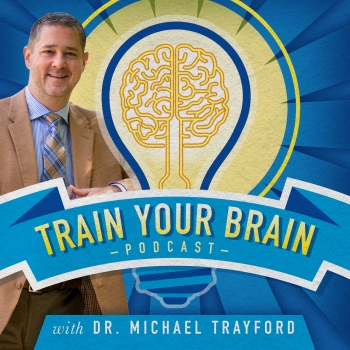Podcast: Play in new window | Download
Good morning and welcome to Episode 68 of the Train Your Brain Podcast with Dr. Michael Trayford. Every Monday we produce a 30-minute episode. Tuesday through Sunday we produce episodes with five-minute tips. Every episode of the Train Your Brain Podcast features a tip, so you can receive pointers 365 days a year that will help enhance the performance of your brain!
If you are looking for something simple that you can do that isn’t too strenuous, then tip number 68 is the ticket! Today Dr. Trayford teaches about gaze stabilization. Gaze stabilization is an eye exercise where you train your eyes to hold steady while looking at a target. Listen in as he explains exactly how to conduct this exercise. Have someone check your eyes to see how often your eyes stray and then practice this technique several times a day. This will help you develop the ability to track a moving target as well has hold your gaze on a still target. And of course, all of this will help your brain function more efficiently.
This tip is an entry -level tool for helping to build better function of the eye movement system. Gaze stabilization is really important. It relates to our ability to hold our eyes on a target. Now there are elementary speaking, there is so much to get into here.
To hold your eyes on a target deals with more primitive brain function. In the tri-brain theory this relates to the reptilian brain, which helps us to identify if something is a friend or foe.
While holding your eyes on a target relates in many ways to primitive brain stem function it also relates to aspects of our frontal cortex, which is central to defining your humanity and advanced cognitive ability.
Most people don’t necessarily equate eye movements or the ability to hold your eyes on a target with overall brain function. This is something that we’ll elaborate on in the longer podcasts.
The most basic activity is holding your eyes on a target. If you’re looking at a spot on the wall, it might be hard to tell if you’re truly holding your eyes on a target. People often experience square-wave jerks, which are an involuntary movement that pulls the eyes off the target instantaneously. People might not be able to tell that they’re actually doing it.
In the past we’ve discussed the VNG or Videonystagmography testing. But really it can be as simple as holding your finger in front of your eyes and watching to see if the eyes stay on the target will tell you a lot about gaze stabilization.
If your eyes can’t hold a target, they can’t follow a target or catch up to a target. This leads to additional dysfunction in cognitive function and ability to focus. Children with ADHD or has suffered brain injury often struggle to hold their eyes on a target.
This is something you should discuss with your physician or a physician versed in functional neurology. What you want to do is simply look at a target that’s about arm’s length away, at eye level. Then turn your head from side to side, fairly slowing. With about two seconds per turn of the head. Do 10 repetitions, two or three times per day to start training these systems.
If there are challenges that you’re experiencing, you need to get with a physician that can help you with treatment intervention.
If you have any concerns regarding the information and applications discussed in this podcast, please consult your physician and a doctor who is experienced in functional neurology. Michael Trayford DC, DACNB is available for consultation by calling (828) 708-5274. Thanks for listening.
Links for this episode:
Click here to learn more about helmets
Learn more at APEX Brain Centers.com
Read the APEX Brain Centers BLOG
Follow us on Facebook
On Google Plus
Follow APEX Brain Centers on Twitter
And here is the Twitter handle for this podcast: @BrainPodcast365
Visit our YouTube Channel

